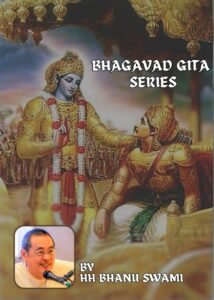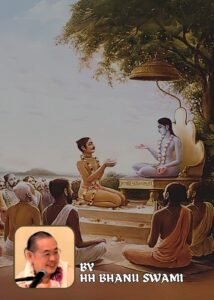Texts 13-14
na cāntar na bahir yasya
na pūrvaṁ nāpi cāparam
pūrvāparaṁ bahiś cāntar
jagato yo jagac ca yaḥ
taṁ matvātmajam avyaktam
martya-liṅgam adhokṣajam
gopikolūkhale dāmnā
babandha prākṛtaṁ yathā
Translation
The Supreme Personality of Godhead has no beginning and no end, no exterior and no interior, no front and no rear. In other words, He is all-pervading. Because He is not under the influence of the element of time, for Him there is no difference between past, present and future; He exists in His own transcendental form at all times. Being absolute, beyond relativity, He is free from distinctions between cause and effect, although He is the cause and effect of everything. That unmanifested person, who is beyond the perception of the senses, had now appeared as a human child, and mother Yaśodā, considering Him her own ordinary child, bound Him to the wooden mortar with a rope.
Purport
In Bhagavad-gītā (10.12), Kṛṣṇa is described as the Supreme Brahman (paraṁ brahma paraṁ dhāma). The word brahma means “the greatest.” Kṛṣṇa is greater than the greatest, being unlimited and all-pervading. How can it be possible for the all-pervading to be measured or bound? Then again, Kṛṣṇa is the time factor. Therefore, He is all-pervading not only in space but also in time. We have measurements of time, but although we are limited by past, present and future, for Kṛṣṇa these do not exist. Every individual person can be measured, but Kṛṣṇa has already shown that although He also is an individual, the entire cosmic manifestation is within His mouth. All these points considered, Kṛṣṇa cannot be measured. How then did Yaśodā want to measure Him and bind Him? We must conclude that this took place simply on the platform of pure transcendental love. This was the only cause.
advaitam acyutam anādim ananta-rūpam
ādyaṁ purāṇa-puruṣaṁ nava-yauvanaṁ ca
vedeṣu durlabham adurlabham ātma-bhaktau
govindam ādi-puruṣaṁ tam ahaṁ bhajāmi
(Brahma-saṁhitā 5.33)
Everything is one because Kṛṣṇa is the supreme cause of everything. Kṛṣṇa cannot be measured or calculated by Vedic knowledge (vedeṣu durlabham). He is available only to devotees (adurlabham ātma-bhaktau). Devotees can handle Him because they act on the basis of loving service (bhaktyā mām abhijānāti yāvān yaś cāsmi tattvataḥ). Thus mother Yaśodā wanted to bind Him.
HH Bhanu Swami Maharaj :
So this verse is describing how Mother Yasoda was attempting to tie up Krishna.
But we say that Krishna is the supreme Lord, the highest spiritual entity. This seems to be impossible. What is the reason for this? So by nature the supreme entity has no limitation.
So we cannot measure Him and say He is so many feet high or so many feet wide. We cannot measure Him and say He is so many feet high or so many feet wide. We try to measure everything including the universe. That is why we say that the universe is so many trillions of kilometers across. Krishna has no limitation so He is bigger than that. Ultimately if He has no size at all and no limit, a beginning or an end or whatever or a height or whatever, then He does not really have a form.
Ultimately if He has no size at all and no limit, a beginning or an end or whatever, then He does not really have a form. That is why many people believe that they cannot measure the supreme Lord because they believe that He does not have a form. No beginning and no end.
He is not subject to time in any way. So He is something eternal with no form. At the same time, we see that scripture describes that He is the biggest but He is also the smallest.
We speak of Krishna as Para Brahman with human form. So human form means something we can measure our size. So simultaneously Krishna is beyond measurement and beyond time but still He is also measurable in one sense. We can say He has no form but He also has form. So this indicates that the supreme Lord is actually beyond human understanding and logic. And the scriptures directly state this.
It is directly stated in the Upanishads that the Lord is beyond mind, anything you can imagine and anything you can describe in words. Of course, one reason is that there are contradictions within the Lord. So we say the Lord is big and the Lord is small. So there is a contradiction. And contradictions do not make sense. So He tried to describe by words but the words are contradictory. Then it does not make any sense. So He cannot be described in that way. In the Upanishads, the Lord is described as being very far but very near.He walks but He does not walk. So all this is beyond our material conception. Krishna can be simultaneously big and small.
Simultaneously He has form and does not have form. So this is one of the facts which is presented in the Srimad Bhagavatam. The Lord is full of what seems to be contradictions. And by our normal material understanding, it does not make sense. If we get spiritual realization, to some degree we can understand. But we are beyond material mind and material words.
So the purpose of scripture is to communicate to us this inconceivable nature of the Lord. It presents us with all the contradictions in the Lord. And we read them but we cannot understand them. But what we can understand is that the Lord is beyond our human understanding. When we become realized and we are beyond human understanding completely, then we can understand. So the scriptures give us some indication of the nature of the Lord, at the same time telling us that we cannot completely understand Him with the material mind. But the words of scripture are useful for us, because they give us some guidance for generally how to perceive the Lord. So therefore the descriptions of the Lord in scripture are not useless. Scripture says the Lord is beyond material words and material mind. But scripture is not material words. And therefore scripture can describe the Supreme Lord. At the same time, we will only get the real meaning of that when we get realization. Of course, if we at least have faith and a little devotion, we get some understanding. But if we have no faith and no devotion, then we really cannot understand. And thus it is said, Bhagavatam is available to the devotees, but not available to the non-devotees. So the materialist reads, it doesn’t make sense. And the Jnanis read, they will take the whole Bhagavatam as ultimately having an impersonal conclusion. They will conclude that the way to get rid of all the contradictions is to say that all of the contradictory elements are illusory.
So only the devotee can understand how the Lord has opposite qualities. However, when the devotee reaches the highest stage, he also goes beyond seeing opposite qualities or inconceivable nature in the Lord. When Mother Yasoda saw the universe inside Krishna’s mouth, then she thought, oh, the universe is in Krishna, but I am holding Krishna in my lap, and the universe is outside Krishna.
When Yasoda saw the universe in Krishna’s mouth, then she thought, oh, the universe is in Krishna’s mouth, but I am holding Krishna in my lap, and the universe is outside Krishna. He must be the Supreme Lord. But then she forgot everything. This is impossible. Krishna is only my son. So they go beyond this realization of Krishna’s inconceivable nature and powers, and they just think of Krishna as their son.
So what this indicates, yes, Krishna has contradictory qualities, etc., but the sweetest realization of the Lord is to realize Krishna with His form, qualities, and activities. So in other words, there is emphasis more on the sweetness aspect of the Lord than His powerful aspect.
Of course, if one prefers the powerful aspect, one can realize the Lord in that way also. However, for those who choose the sweetness aspect, that is available in Krishna, and through that, those devotees get the highest bliss. So in this verse, we see that by nature, yes, Krishna, even though He looks like a small boy, He has these inconceivable qualities.Yes, He cannot be limited by any aspect of space or time. But Mother Yasoda doesn’t care about that. Krishna is my son, He is very naughty, therefore I have to tie Him up.
That’s her attitude. It is not an illusion to see Krishna as a child. At the same time, Krishna is two-fold. At the same time, the Supreme Lord and the Supreme Soul are as one. The Supreme Lord is Brahman. So the devotees follow the process of bhakti, they realize Bhagavan. Jnanis follow the process of jnana, they realize impersonal Brahman. But Bhagavan is one.
The devotees choose Bhagavan’s form, the jnanis choose Bhagavan’s impersonal Brahman . Bhagavan reveals different forms to different types of devotees. So, Mother Yasoda, being a devotee and also being the highest devotee, doesn’t give any regard to the impersonal aspect or the inconceivable aspects.
Krishna appears as her child. And then she tries to tie him up. So, as Prabhupada mentions in the Purport, this is available for the devotee, not for the non-devotee. The devotee establishes a personal relationship of service with the Lord, but jnanis, yogis or karmic devotees, do not. So, the devotees are in a special position. Mother Yasoda, very great devotee, therefore very special position, very special service.
So, no one else gets to tie up Krishna, but Mother Yasoda does. Even Nanda doesn’t do that. Mother Yasoda is doing it. So, she is in a very, very special position. And she succeeds in doing it.Why? Because of her devotion. Ultimately, Krishna is bound not by ropes, but by devotion.
Q & A
1) One big contradiction, like how can a Nitya Siddha have many different forms in this material world? Like Tulasi, there are millions and millions of forms in this planet. Or Shiva, he manifests himself like a Hanuman, or a devotee, or a guru, in different worlds. How can a Nitya Siddha have many forms?
We are talking about Jivas. Well, of course, not only Tulasi. We will find that Krishna appears in every universe. He is in different universes at the same time. He is also in the spiritual world. So, Krishna can manifest himself in many forms. Not only Tulasi, Krishna also appears in many universes at the same time. He has many forms. He is also in the spiritual world. Anyway, Krishna can take many forms at the same time. But Krishna is never alone. He is always with his devotees. And he is in another universe also, with the same Yasoda, Nanda and the Gopis.
So, not only Krishna can manifest many forms, but the devotee also, by Krishna’s arrangement, also has many forms. The Jivas cannot do this on their own. They are not like the Supreme Lord. But the Supreme Lord makes this arrangement. So, in this way, not only Krishna has multiple forms, even the devotees, by His will, also manifest many forms.
2) We have heard that Sadhakas, who are aspiring for a particular rasa, so they should hear about the Vrajvasis in that particular rasa. And the example often given is of Mother Yasoda. So, those who want to cultivate Vatsalya rasa should hear more about Yasoda.
So, now in ISKCON, we understand that Madhurya rasa is the topmost, but we do not hear anything or any pastime related to Madhurya rasa. So, how the Sadhaka will cultivate that mood, Maharaj?
So, after explaining the Vatsalya pastimes in the first chapters of the 10th canto, then Sukadeva Goswami describes Sakhya rasa in the Poganda period. And when Krishna enters Kaishore period, then Sukadeva Goswami describes the pastimes of Krishna with the gopis, the Madhurya rasa. And this culminates in the five chapters on the rasa lila. So, then devotees who are aspiring for Madhurya rasa, then they concentrate on those particular descriptions. Maharaj, but in those five chapters, we know that Madhurya rasa topmost is Srimati Radharani and then there is no direct mention also. And in the classes, whatever we hear, so generally this topic is not discussed, Srimati Radharani, any topic or pastime related to Radharani. Her name is not mentioned, but then our Acharyas point out that when the rasa lila was on, then Krishna left with one particular gopi. So, that is identified as Radha. So, he went off with one particular gopi.
3) In Bhagavad Gita 15.16 it is stated that the Lord is simultaneously very far from everyone else, at the same time He is very near by everyone. So, these two statements are appearing as contradictory statements. So, how can we understand this?
Of course, we know that the Lord is in all the Jivas. So, He is very close. He is actually inside you. Then, of course, He is there as Garbhodakshayi Vishnu, as Mahavishnu, and as forms in the spiritual world which are very far away. However, in either case, for a materialist, Krishna is far away. Though He is within the Jiva, the materialist never realizes that form. The Upanishads describe how there are two birds in a tree, so they are sitting in the same body, but the Jiva is not looking at the other bird, doesn’t even know He is there. But the devotee realizes the Supreme Lord.
It doesn’t matter whether He is inside or outside or near or far, there is no distance at all. A devotee in Prema directly associates with the Lord. He is right next to the Lord. So, there is no distance at all. Of course, we say the spiritual world is very far away. But for the devotee who is in Prema, no, it is not far away.The spiritual world is within that devotee. So, therefore, as I said, when one becomes realized, all these material concepts of near and far, big and small, dissolve. There is no longer such conceptions.
4) Sakhya Rasa or Madhurya Rasa is selected by the Jivas or Krishna gives them?
The Lord responds to whatever the Jiva desires. If you desire a material world, the Lord gives you a material world. If we desire to worship Vishnu or Rama, then the Lord gives that realization. And if we desire Krishna and a particular relationship with Krishna, Krishna also responds to that. He never forces us to take anything. The Lord never forces anyone to take anything.
5) Can you please help to understand about the Tattva of Srimati Radharani?
Well, as we know, Radharani is Hladini Shakti. Radharani is Hladini Shakti. This is part of the Antaranga Shakti or internal energy. Jivas belong to Tatastha Shakti, different Shakti. But in either case, both Shaktis are dependent on the Supreme Lord. Of course, the Antaranga Shakti or Hladini Shakti are very special. Antaranga Shakti or Radharani Shakti are very special. Those Shaktis can never be bound by material energy. So, we can say the presiding deity of Radharani and embodiment of Radharani is Radha. She is bliss and she gives an experience of bliss. Because bliss is the very nature of the Supreme Lord, then the two are inseparable.
Devotees: Grantharaj Srimad Bhagavatam Ki.. Jai ! Srila Prabhupad Ki.. Jai !! HH Bhanu Swami Maharaj Ki.. Jai !!


